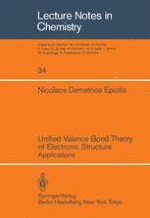
1983 | OriginalPaper | Buchkapitel
The Induced Deexcitation Model
verfasst von : Nicolaos Demetrios Epiotis
Erschienen in: Unified Valence Bond Theory of Electronic Structure
Verlag: Springer Berlin Heidelberg
Enthalten in: Professional Book Archive
Aktivieren Sie unsere intelligente Suche, um passende Fachinhalte oder Patente zu finden.
Wählen Sie Textabschnitte aus um mit Künstlicher Intelligenz passenden Patente zu finden. powered by
Markieren Sie Textabschnitte, um KI-gestützt weitere passende Inhalte zu finden. powered by
In complex scientific disciplines, such as chemistry, a command of the literature and an ability to recognize the common denominator of many apparently unrelated experimental observations often leads to the formulation of concepts and rules of broad applicability. One demonstration of how such a marriage of knowledge and intuition can bear offspring was given by Walsh, who, many years ago, recognized that many experimental facts, which were known at that time, could be explained in a self-consistent manner by assuming that the hybridization of a central atom (or core) depends on the electronic nature of the ligands attached to it and proposed the following rule: “If a Group X attached to Carbon is replaced by a more Electro-negative Group Y, then the Carbon Valency towards Y has more p Character than it had towards X”.1 We shall refer to this as Walsh’s rehybridization rule. In recent times, this rule, in one form or another, has been applied to a variety of interesting chemical problems by many, most notably by Bent2.